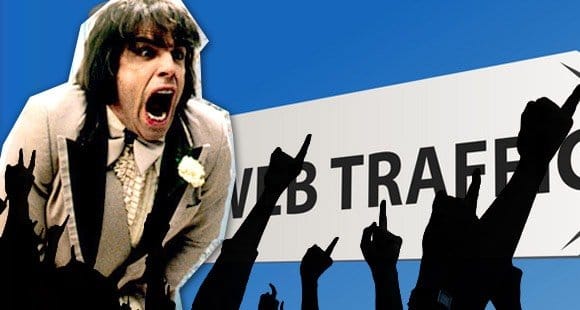The Difference Between Good Traffic and Bad Traffic

There are several kinds of traffic you can get as a website owner, and chances are you’re going to see them all, often at the same time. Your goal, through advertising, SEO and smart decisions, is to encourage the right kind of traffic and discourage the wrong.
Bad Traffic: The Bots
Robotic traffic is the worst of the worst. Software with no human interaction visits your site. Your hit counter goes up by one. The robot might click a link and visit another page, or it might just back away, all in less than a second. Your bounce rate typically increments by one when this happens.
Where does bot traffic come from? Most of the time, it’s directed at your site for one reason or another. Most often, this is what happens when you purchase traffic from a low quality user on a site like Fiverr. Other bots crawl the Internet, looking for open submission forms and comment fields. If they find them, they fill out a comment with spam content and links, or fill a submission form with garbage information. Captcha security tries to prevent this, but can be circumvented by other robots.
Bots aren’t all bad, however. After all, Google uses them, as does every other search engine. Search engines use robots to crawl pages, recording data about them and building a virtual image of them inside the index. The difference is that bots like the Googlebot announce and identify themselves as bots. You can easily click a button in Google Analytics to filter bot traffic that announces itself. It doesn’t affect you in a negative way and it never spams you.
Bad Traffic: The Clickfarms
Clickfarms are the next step up on traffic, but they’re almost as bad as bots. A clickfarm is typically a bank of human beings in a developing nation such as Egypt, India or Bangladesh. This group of people spends their days running numerous Facebook accounts and browsers, liking pages and clicking links.
Clickfarm traffic is bad for one reason, and this is a reason you’re going to see come up in every form of bad traffic; no engagement. A robot has no engagement with your site. A clickfarm worker has no engagement with your site. Even the most relevant human being living next door to your business is bad traffic, if they have no engagement with your site.
Clickfarm traffic is easy to identify, at least, due to its location of origin. The reason developing nations are the source is because the cost of living is so much lower than in the nations of the people buying traffic. $5 can go a long way in Dhaka. Thankfully, if you’re not buying terrible traffic from shady sellers, you’re unlikely to encounter much in the way of clickfarm traffic.
Median Traffic: Disinterested Users
The next step up is the more legitimate traffic source; real users.
Why are real users bad? Well, they’re not necessarily bad at all. That’s why they’re listed as median traffic rather than bad traffic. See, having a large presence of incoming disinterested users isn’t a bad thing, directly. In fact, if you’ve ever had a post – infographic, video, top ten list or whatever – go viral, you know a huge amount of traffic comes in but the engagement numbers are low.
The problem with a disinterested user is that they’re so close, and yet so far, to being a valuable addition to your page. It’s like attracting a vegan foodie to your blog about bacon recipes. The venn diagram of your interests is an almost perfect overlap, save for the one factor – in this case, the bacon – that keeps them from converting.
So what are some warning signs that you have disinterested traffic?
- Your pure traffic numbers are up, but your conversion rates are low and you have low engagement.
- Your traffic is high, and almost none of it is coming from outside of the country.
- Your bounce rate is unusually high and your time spent on site is low.
- Users coming in from referrals aren’t converting.
How can you take steps to weed out disinterested users or make them more interested? That’s a whole other topic in itself, but here are some basic tips:
- Make sure your site has a clear goal, generally of selling your product.
- Make sure your site has a clear focus on achieving that goal through your content.
- Make sure your advertising is targeting the right kinds of users.
Demographics are important here. With the vegan and bacon example above, it does you no good to run advertising that targets vegans; you know they’re never going to convert. Of course, real world advertising is never so simple. Instead, you have to monitor the types of users who actually convert on your site, figure out what sorts of people they are, and target more people like them.
Good Traffic: Interested Users
So how about some good traffic? One of the best kinds of traffic you can get is the interested user.
Who is the interested user? Well, for your bacon recipes site, they’re people who love bacon. They’re the people who visit your site and stick around for a while. Maybe they click through five or six pages before checking out what products you sell. Maybe they bookmark your site for later reading. Maybe they share a favorite post on Facebook or tell their Twitter friends about your page.
All of those actions fall under the heading of engagement. Your interested users are the users who stick around and do something that helps your site.
In order to attract these users, you need to know who they are. That means taking a good, long look at your analytics. You can filter your traffic by engagement, and you can see the demographic information about the people who are most likely to engage. This gives you a good way to see what sorts of people you need to target in the future.
Good Traffic: Interested Content Creators
You may have raised an eyebrow at the mention of “one of the best” kinds of traffic above. You may also have noticed one type of engagement left off the list. That’s because there’s one even better type of traffic you can attract; content creators.
One of the most powerful search metrics is a backlink. A good, followed backlink from a relevant blog is incredibly useful. If you can attract users who are both interested in your site and owners of a similar site, you can develop an excellent partnership. This gives you a ready source of quality backlinks. If you can find these users, nurture them; they’ll promote your site indefinitely.
 ContentPowered.com
ContentPowered.com







